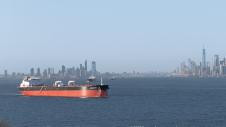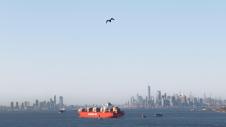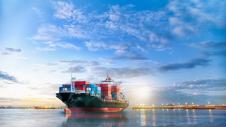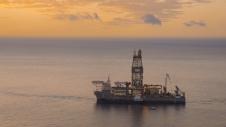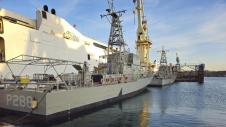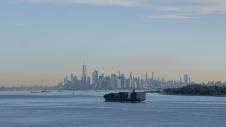In retrospect, 2023 was not the promised year to be for the international shipping industry. Post-Covid19 recovery compounded with stimulus packages, supply chain disruptions and a largely unpredicted war in Ukraine supposed to had set the stage in 2023 for a remarkable year of freight rates for tankers of all types, dry-bulk vessels and containerships. Not that 2023 has been a bad year, as freight rates have been profitable overall, but mainly it has been a year of betrayed (high) expectations.
In another way that 2023 will be remembered for the shipping industry, and many other markets such as financial and stock markets globally, it was the fact the year was well-behaved in terms of volatility and market gyrations, as that would have been measured in variance between annual troughs and peaks, or even standard deviation, for charter rates and vessel values.
There have been spikes here and there, but generally subdued and short lived. For instance, while in the fall of 2022 an LNG tanker was chartered at $500,000 daily rate on the spot market (and the LNG tanker market was above $200,000 per diem for four straight months consecutive months in 2022), in 2023 the LNG tanker market topped barely at $200,000 per diem, and that only for two weeks. Respectable numbers in any sense of the word, but not the volatility people were primed to expect in 2023.
In a way, low volatility and bland freight rates have proven wrong many people in 2023, ourselves including, as we were expecting scenarios of a volatile market for 2023 in an article from a year ago. Given the world uncertainty, we thought that the impact on shipping would have been more pronounced in 2023. The major premise had been that there were enough friction points globally — whether geopolitically, economically or logistically—that shipping freight rates had to derivatively explode. Apart from a couple of minor spikes, the year had been forgettable in that respect. Should we relax and expect another tame year for the shipping industry in 2024?
Not another tame year
Probably not, in terms of volatility, we would like to think; all the (geo-political and other) ingredients for a volatile market are still there; more importantly, there does not seem to be consensus on how these friction points may be remedied once having occurred. And, some solutions may just be in the realm of nature, beyond human control.
For starters, the war in Ukraine keeps dragging on, and besides the humanitarian and economic costs, the risk to world’s food supplies keeps getting more precarious. The Black Sea region produces more than a quarter of the world’s grains, and its production and shipping get more periled by each day of the war. In this respect, global food supplies and their shipment become critical, especially since the logistics of transporting and storing grains are much more demanding than let’s say ores or coal. And, grains, as natural resources, may be impacted by extraneous variables such as weather.
In 2023, the grains harvest in the US has been disappoint weak due to a very hot summer, and thus, global supplies and inventories have been lower than usual, creating the potential for volatility in the grains market and their shipment thereof.
The war in Ukraine is not the only geo-political conflict globally affecting the shipping industry. Just this month, the Bab-el-Mandeb Strait in the Red Sea has brought havoc to shipping and the short-circuited routes between Pacific-Indian Ocean and Mediterranean Sea via the Suez Canal. One has to consider the Strait of Hormuz as one of shipping’s perennial choke points (especially for oil) as well. If one takes at face value China’s imperial ambitions against Taiwan, then the Taiwan Strait ought to be added to the list. We ignore the garden variety piracy hot spots at Somalia, Nigeria and elsewhere, as these are not state sponsored navigation risks. Thus, navigational risks are high.
Geo-political events probably have become harder to resolve in our age, or at least to predict. As recently as a decade ago, a rules-based world order led by the USA could more-or-less depended upon to resolve global conflicts, or at least set them on a path along a resolution; generally, the UK, western Europe (now EU), Japan and similarly minded countries were expected to support such US-led approach. In today’s world, there is a vocal effort by countries like China and India for a multi-polar world, by reason of either to curtail the US influence or to promote their own countries’ agenda. Earlier this year, the so-called BRICS bloc of countries —Brazil, Russia, India, China and South Africa— expanded into the «Global South» in an effort to counter-balance US and «North» industrial might.
Leaving good intentions and noble ambitions aside for now, one has to wonder of who provides global leadership when addressing current conflicts. A multi-polar world may sound cuddly and appealing, to an extent, but again, when navigational choke points are threatened, it does not seem that the «multi-polar» navy fleets of China and India and the Global South have much involvement in the Red Sea, as it presently the case (despite the fact that unimpeded Red Sea and Suez Canal navigation is critical to the economies of the Global South countries as well). The bottom line is that a multi-polar world seems to allow for world conflicts (and their bad actors) to cause more havoc, and, thus, increasing volatility in the shipping industry.
Political risk may even be more unpredictable in 2024 as approximately forty per cent of the global population, where elections are held, get to vote this year, possibly bringing about a re-alignment of political priorities and objectives. Elections in Taiwan, India, Indonesia and Bangladesh may be more notable, and early elections in the UK also possible, but probably the most critical national election in 2024 is the one in the US, where there is the potential of a drastically different global engagement (or not) in 2025. The outcome of the US elections is a scenario whose importance cannot be emphasized enough, and its impact on policy, diplomacy and trade, and the impact on shipping can be monumental. That’s another notch higher in the risk and volatility scale.
Natural events, like rainfall, may be affecting harvests and food supplies globally, but they also have a tremendous impact on the shipping industry in more direct ways. The Panama Canal has seen transits drop from 1,002 in October to 783 in November this year, with an average monthly transit of 1,150 in 2021 and 2022, due to low water levels at the Gatun Lake. Global warming, rising sea levels, unpredicted and violent changes to weather patterns all affecting global shipping by delaying ships or forcing them to take longer routes and thus artificially increasing tonnage demand (think higher freight rates, at least temporarily, thus more volatility).
And, unlike geo-political events where there may be subject to reason and negotiation, rainfall is an Act of God, and the Panama Canal may work or not in the future just because of weather. In a world where Panama Canal was a «given» just a few years ago, now shippers have to learn to plan around it so much so that a recent headline made the point that shipping has recently defaulted to 18th century sailing patterns around the Cape of Good Hope and the Cape Horn of the clipper vessels, given with Panama Canal and Suez Canal recent developments.
We do not hold a gloomy view of the world, but we note that there are concern points on fronts at different plateaus that pose a risk to the status quo, and thus they be catalysts for high impact events on the world stage, affecting the shipping industry. While these very same concern points were innocuously present in 2023, they may have another chance to flare up in 2024; and, as these are friction points that get worse with age (for example, as the war in Ukraine drags on, the stakes get higher in terms of cost of economic, social and political capital), the price for resolving them gets higher as the chances get lower, leading to higher volatility. But once again, the shipping industry thrives on volatility, which may not be a bad thing for the industry itself, at least in the short term.
*Basil M. Karatzas is the Founder of Karatzas Marine Advisors & Co and Karatzas Auctions, active in the maritime industry as financial advisors, shipbrokers and marine appraisers. Mr Karatzas is a Certified Marine Surveyor, an Accredited Senior Appraiser for marine assets, and a Fellow with the Institute of Chartered Shipbrokers in the UK.



